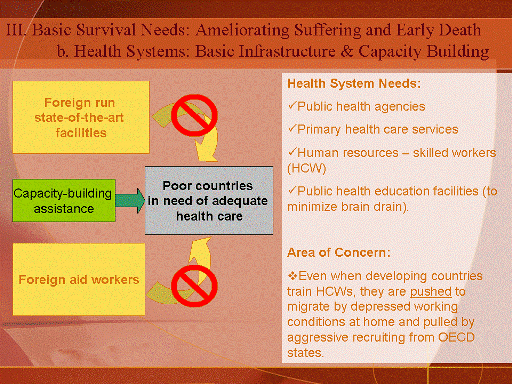Search for most updated materials ↑
| front |1 |2 |3 |4 |5 |6 |7 |8 |9 |10 |11 |12 |13 |14 |15 |16 |17 |18 |19 |20 |21 |22 |23 |24 |25 |26 |27 |28 |review |
 |
C. Health Systems: Basic
Infrastructure and Capacity Building
There is little doubt that
the single most important way to ensure population health is to
build enduring health systems in all countries. States and local
communities must possess well-functioning public health and health
care systems with sound infrastructures and skilled human resources.
If the vast preponderance of international assistance went into
helping poor States develop and maintain health systems, it would
give them the tools to safeguard their own populations. What poor
countries need is not foreign aid workers parachuting in to rescue
them. Nor do they need foreign run state-of-the-art facilities.
Rather, they need to gain the capacity to provide basic health
services themselves.
Health systems include
public health agencies with the ability to identify, prevent, and
ameliorate health risks in the population—disease surveillance,
laboratories, data systems, and a competent workforce. They also
include primary health, bringing basic medical services as close as
possible to where people live and work—maternal and child health,
family planning, and medical treatment. Primary care promotes
individual and community self-reliance and participation in the
planning, organization, operation and control of health services,
making fullest use of local and national resources.
Human resources are
critically important for well functioning health systems. But the
availability of skilled health workers is dangerously low in
developing countries. In a cruel twist of fate, countries with the
highest burden of disease also garner the lowest proportion of the
global health workforce. Southeast Asia, which shoulders the largest
share of the global disease burden, has only 12% of the world’s
health workforce. Africa has only 3% of health workers worldwide. In
contrast, North America and Europe command a far larger share of
health and medical professionals than their need would indicate.
Poor countries often do not
have the public health, medical, pharmacy, and nursing schools
necessary to train sufficient numbers of HCWs. But, even when
developing countries do train HCWs, many leave for more lucrative
positions in richer countries. For example, in Ghana and Liberia,
30% and 60%, respectively, of the country’s physicians are working
in the U.S. or U.K. Physicians in middle income countries such as
India and Pakistan are similarly moving to the West in droves. The
migration of HCWs is caused by a “push” from depressed working
conditions and opportunities in poor countries and a “pull” from
more attractive conditions elsewhere. North America and Europe
represent an overpowering lure for doctors and nurses, offering
salaries and career opportunities that far surpass what could be
offered in a poorer country. The problem is not simply due to
diffuse global market forces. Rather, OECD countries are
aggressively recruiting HCWs, even as they acknowledge the resulting
dire situation in poor countries.
This “brain drain” is
leaving poor countries – as many as 57 by WHO calculations – unable
to meet the MDGs because of a shortage of HCWs. Africa would need at
least an additional one million health workers just to offer the
services that could meet the MDGs.
|